Castles have long struck humans with awe and wonder at their magnitude and majesty.
Great Britain — where you can find one of the world’s longest-standing monarchies — has a long and rich history with castles. The island is home to all types of castle structures, from towering castle fortresses to still-occupied royal palaces, as well as a myriad of historic ruins.
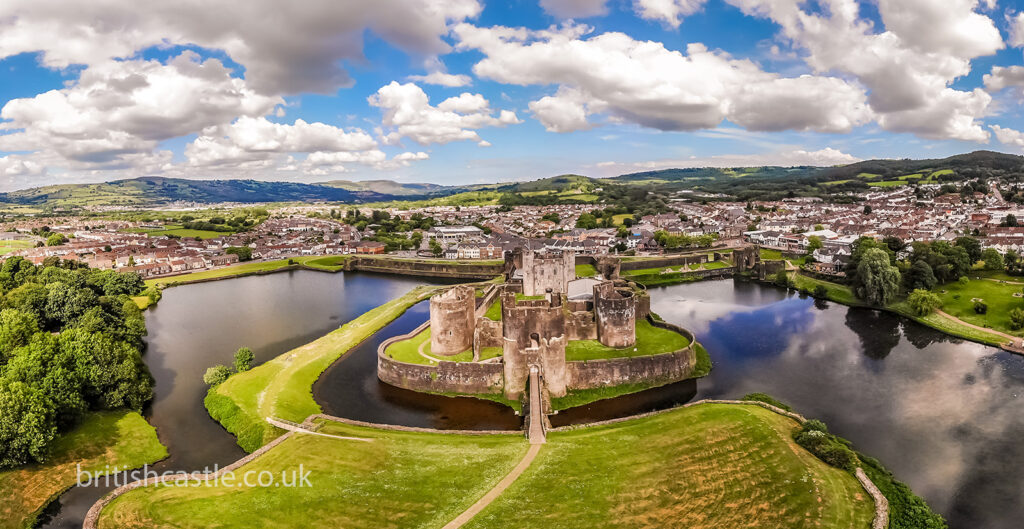
When it comes to exploring the past of Great Britain’s castles, there are countless stories and historical accounts to fill your time. No matter if you are a history buff, a castle fanatic, or simply interested in learning about Great Britain’s architectural history, the diverse range of castles found within the region has something to offer to people of all tastes.
In this article, we dive deep into the colourful, innovative, and sometimes brutal history that came to create so many beautiful castles in Great Britain. Each castle has a unique story to tell, with many still open to visitors who wish to experience the halls of these magnificent structures first-hand.
Keep reading to learn all about the history of castles in Great Britain and the UK, as we cover the history not only of castle-building in the region but also the diverse histories of specific castles and palaces in England, Wales, Scotland, and Northern Ireland.
A Brief Intro to British Castles: How Many Castles Does Great Britain Have?
Great Britain is the name of the island that comprises the three main countries of the United Kingdom (UK) — England, Scotland, and Wales. The UK also includes Northern Ireland, found just to the west of Great Britain on the larger nation-island of Ireland.
The total number of castles found throughout the entirety of the UK is not entirely known, as this number can depend on how a “castle” is defined, whether the total count includes castle ruins, and other factors.
In England, for example, there is a large debate as to how many castles the nation actually houses. Some estimate the number to be more than 4,000, while others believe it to be closer to 1,000.
The Casellarium Anglicanum— a bibliography of castles in England and Wales published in 1983 — lists more than 1,500 castle sites within England alone, though many of these are little more than merely historical records of ruins or long-vanished castles.
It’s safe to say that across the whole of the United Kingdom, thousands of castles have risen and fallen throughout human history. The castles that remain standing today serve as poignant reminders of the tenacity of the human spirit and the continued glory of the UK.
Who First Created Castles?
Before diving deeper into the history of castles in Great Britain, let’s first look at how the very first castles in the entire world came to be.
Although human beings were likely experimenting with castle and fortress construction for hundreds of years in the ancient era, the Ghumdan Palace is generally accepted as the oldest known castle in the world. Located in Sana’a, the capital city of Yemen.
Though much of the Ghumdan Palace now lay in ruins, the palace served as an iconic symbol in Arabic culture, inspiring early Arabic poetry with its grandness and beauty. The site is now part of the UNESCO World Heritage Site of the Old City of Sana’a.
Another ancient structure regarded as one of the world’s oldest castles is the Citadel of Aleppo, with the earliest construction on the famous structure dating back to as early as 3,000 BC. The bulk of the features that remain today were constructed between the 12th and 14th centuries by Arabic military forces.
The Citadel of Aleppo is also recognized as a UNESCO site as part of the larger Ancient City of Aleppo.
Just before the 12th century when major construction was under way at the Citadel of Aleppo, castle-making had made its way to England in the 11th century thanks to the Norman Conquest of 1066.
The stone castle building techniques brought to England by the Normans would prove to be a long-lasting architectural style, with stone castles reigning as the predominant castle type up until 1,500 AD.
The First UK Castle Sites: Great Britains Oldest Castles
Windsor Castle is almost universally accepted as the oldest castle in Great Britain.
Located in the Berkshire county of England, this castle housed some of Great Britain’s most famous rulers and royalty — including William the Conqueror, the Tudors, and Queen Victoria. William the Conqueror was, in fact, the person to choose the building site for the castle, beginning construction around 1070.
It would take roughly 16 years to complete Windsor Castle and the castle would go on to receive many modifications and new construction from the rulers that followed.
Along with being the oldest castle in England, Windsor Castle is also the largest and remains a royal residence for the British monarchy’s royal family.
Interestingly, the castle would be victim to a fire in November of 1992 after Queen Victoria’s private chapel after a faulty spotlight set the altar curtain ablaze. Before the fire was finally contained, it had destroyed 115 rooms within the castle, according to BBC News.
Windsor Castle would go on to be restored in 1993, though restoration efforts took five years to complete.
Today, tourists can visit the restored Windsor Castle and view a variety of state apartments, historic rooms, and iconic pieces of royal history — such as Queen Mary’s Doll House.
If you are interested in visiting Windsor, you view prices and book tickets on the Windsor Castle website.
What Part of Great Britain is Home to the Most Castles?
When it comes to which country in Great Britain has the most castles, the topic can be a hot debate.
Many believe England to be the home to the greatest number of castles, thanks to the royal family calling England home, with some believing the country to be home to more than 4,000 different castles! However, this fact is hotly contested, with many claiming the true number to be somewhere between 1,000 to 2,000 total castle sites — some of which are ruins.
In fact, many of the total castle numbers reported in the countries within Great Britain include castle ruins, making them more castle sites than standing castles.
The county of Northumberland in England is home to more than 70 castles scattered throughout the county countryside and is widely believed to be the English county with the most castles.
Back to the topic at hand, Wales could potentially be the true home of the most standing castles in Great Britain. According to Cadw (the historic environment service of the Welsh government), Wales has roughly 427 castle sites, 44 of which are maintained by Cadw.
Wales is even nicknamed the “Land of Castles.”
As for Scotland and Northern Ireland, the former is thought to have housed more than 2,000 castles throughout its history, with around 65 castles still standing today. The latter’s history with castles is a bit more uncertain, with around 40 standing castles still in existence.
What Types of Castles are Found in Great Britain?
When discussing the many different castles found throughout Great Britain and the greater UK region, it can be hard to pin down an exact number. Part of this is due to the differing definitions of what a castle is and which architectural structures qualify as such.
Almost all types of castles in the UK are based on three main styles of castle:
1. Motte & Bailey Castles: Motte-and-bailey castles were first used by the Normans in the 11th century during the Norman Conquest of England. It is during this time that Windsor Castle was built, which is easily the most famous example of a motte-and-bailey castle. This type of castle architecture is comprised of two main parts — the motte, a raised mound of earth where the castle keep resides, and a bailey, an enclosed courtyard that would include key buildings like kitchens, stables, and forges. Both parts are surrounded by a wooden fence and a ditch as an extra layer of protection. Click here to view an illustrated diagram of a motte-and-bailey castle.
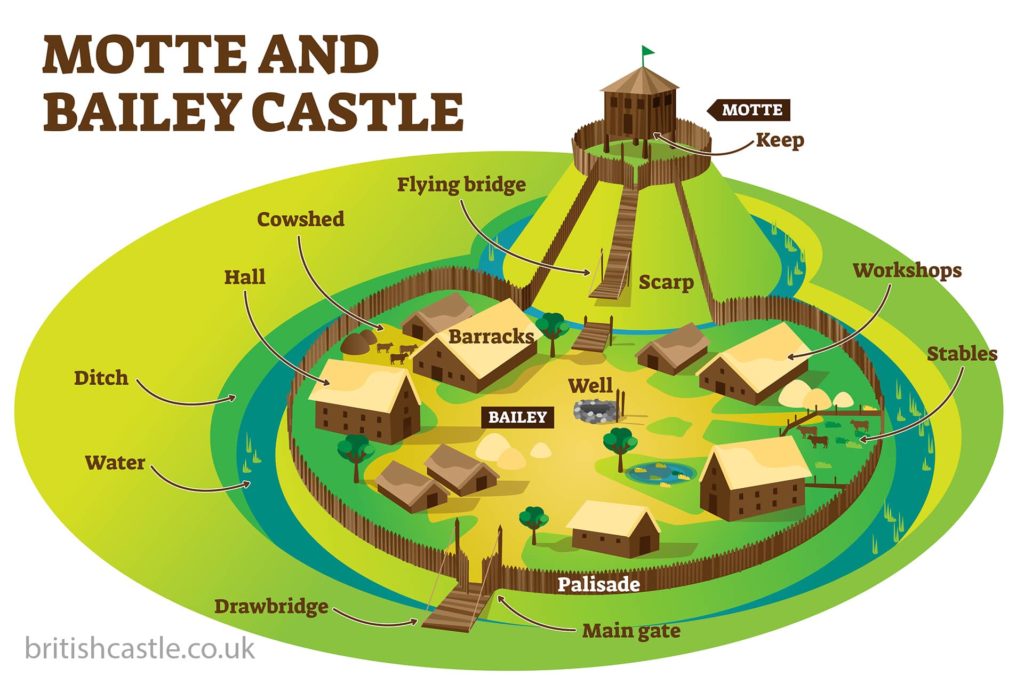
2. Stone Keep Castles: Stone keep castles (also called medieval castles) originated as an evolved version of the motte-and-bailey style. As the Norman Conquest planted more firm roots in Great Britain, stone keep castles quickly became the standard for military fortresses. A stone keep castle has a similar design to its predecessor, with the main difference of stone being used as the primary construction material rather than wood. Additionally, the keep was often surrounded by a taller stone wall with a gated entrance that led into the bailey, also surrounded by a tall stone wall. The most famous example of a stone keep castle in the UK is the White Tower of London.
3. Concentric Castles: As what we know today as Great Britain emerged from the Anglo-Saxon era and became the Kingdom of England, the standard castle style evolved as well. The concentric castle was designed in the 12th and 13th centuries to include thicker stone walls around the keep, as well as an additional wall surrounding the first wall. According to History on the Net, the space between these two walls was specifically designed to trap invaders and became known as the “death hole” where intruders could be cut off from all exits. Beaumaris Castle in Wales is one of the most famous examples of a concentric castle.
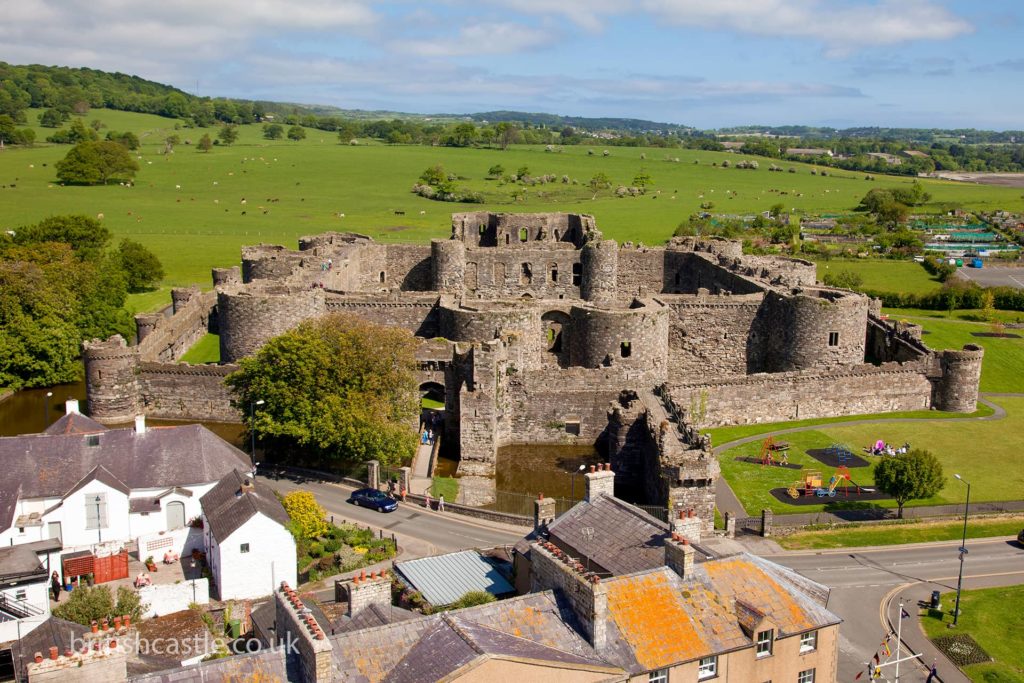
Additionally, England is also home to a variety of royal palaces that are both historic sites and currently occupied by members of the royal family — which we discuss more in the next section.
Other notable types of residences sometimes grouped in with castles and palaces include:
· Fortified Manor Houses: Fortified manor houses are a type of residential structure that grew in popularity in the Middle Ages, a time when war was running amock across Great Britain and the continental nations in Europe. The basic anatomy of a fortified house included a stone house built atop a tower that could not be easily attacked or seized.
· Tower Houses: Tower houses were the base structure that fortified houses were modeled after. These houses were exactly as they sound — a simple, singular tower made from stone that served as both a defensive structure and a residential space.
· Mansions: While palaces were often reserved for royals, the nobility would typically live in stately homes, sometimes referred to as mansions. These mansions would have varying levels of defensive functions depending on who lived there and the mansion’s position within the country. Chatsworth House is a good example of a once-residential house that qualifies as a mansion.
How Do Palaces Differ from Castles & How Many Palaces are in England?
Often-times, palaces and castles are spoken of as if they are the same.
Yet, historically, palaces and castles have served vastly different purposes in English culture.
The simplest way to explain the difference between castles and places is that castles were historically made to be fortified structures for hosting soldiers, knights, and other military personnel — meanwhile, palaces were primarily designed to house royals, their servants, and their royal courts.
As a result, castles tend to have more functional designs intended for defensive purposes. On the other hand, palaces were designed to be luxurious displays of wealth, opulence, and power.
Palaces were not reserved solely for England’s royals, though non-royal palaces are few and far between.
In fact, Blenheim Palace is the only non-royal residence within England to be considered a palace — and even this non-royal palace still served as a home to nobility. The palace was constructed on royal land, gifted to the 1st Duke of Marlborough by Queen Anne in recognition of the duke’s military victories.
How Many Royal Palaces Does Great Britain Have?
Palaces are a tremendous show of wealth and opulence that housed many nobles and royals throughout the UK’s history. Within the entirety of the UK, there are roughly 30 total royal palaces still in use, though there is some debate on how many of these fit within the “palace category.”
In modern times, many palaces that are still in use have come to be known as “royal residences,” as royals and nobility continue to take up permanent residence within them.
England is home to many of these palaces, with 9 being of particular noteworthiness:
1. Buckingham Palace: Buckingham Palace is without a doubt the most famous palace in all of Great Britain, as it is the official London residence of the British monarch. Along with serving as a royal residence, Buckingham Palace is also the administrative headquarters for the monarchy. The palace often hosts state events and occasions where royal hospitality is expected. Construction of the famed palace began in 1703 before eventually becoming the principal royal residence during the reign of Queen Victoria.
2. Hampton Court: Hampton Court is the famed — and, perhaps, infamous — Tudor Palace that served as a royal residence for Henry VIII and his six wives. The palace was constructed in the early 16th century by Cardinal Thomas Wolsey, Lord Chancellor to Henry VIII. Along with providing the backdrop for some of England’s greatest royal dramas, Hampton Court also served as a hotel, theatre, and leisure complex during the 1530s.
3. Kensington Palace: Kensington Palace was first purchased in 1689, originally built as a modest mansion used as a country retreat by William III and Mary II. However, it was George I in the early 1700s who would bring in architect William Kent to adorn the palace with the fine furniture, paintings, and decorations it is known for today. Historic parts of Kensington Palace are open to the public to visit, while other parts of the palace remain in use as offices and royal residences for the Duke and Duchess of Cambridge.
4. Royal Pavilion: The Royal Pavilion has an interesting history within Great Britain. First constructed in 1815 on the orders of King George IV — who, at the time, was George the Prince of Wales. After being used as a royal residence and social center for many years, the Royal Pavilion would eventually be converted into a military hospital during World War 1. It would not be restored to its former glory until 1920.
5. Penshurst Place: Penshurst Place was the family home of poet Sir Philip Sidney, who described the mansion-palace as “handsome without curiosity and homely without loathsomeness.” Today, Penshurst Place is a stately home open to visitors that features 11 acres of stunning gardens and a rich collection of historical artwork, furniture, and other items.
6. Banqueting House: The Banqueting House is not itself a palace but is rather a remnant of the lost Palace of Whitehall. The Palace of Whitehall was once the home of the Archbishops of York, known as York Place until King Henry VIII took the property to create a palace for himself and his then-wife and Queen, Anne Boleyn. The palace burnt down in the late 1600s but the Banqueting House survived, becoming a symbol of the lost palace’s tremendous history.
7. Blenheim Palace: Blenheim Palace, as we discussed earlier, is one of the only non-royal residences to be considered a true palace. Built between 1705 to 1724 as a gift to the 1st Duke of Marlborough John Churchill, the palace would ultimately serve as the birthplace of the beloved Sir Winston Churchill, who became the Prime Minister in 1940. The palace and its property are now a UNESCO World Heritage site, with all 2,100 acres open to the public.
8. Westminster Hall: Westminster Hall is similar to the Banqueting Hall in that it is but one remaining part of a larger palace. The Westminster Hall is one of the oldest surviving structures that once made up the historic Palace of Westminster that was tragically lost to a fire in 1834. Though much of the original palace was destroyed in the fire, the Hall was saved and went on to serve as a legal battling ground for several high-profile trials.
9. Westminster Palace: Though the original Palace of Westminster was destroyed in the 1834 fire, a new palace was built in its stead. The present-day Westminster Palace features a perpendicular Gothic design, with the palace being completed between 1847 to 1852. Along with being open to the public for visitation, today’s Westminster Palace also serves as the official residence for the Speaker of the House of Commons in the UK.
35 of the Most Famous Castles in Great Britain
While England is undoubtedly home to some of the most well-known castles in all of the UK, all of the UK member-nations have stunning castles open to visitors.
Join us as we delve into the histories of 35 castles in England, Scotland, Wales, and Northern Ireland:
20 Famous Castles in England
If you are paying a visit to England, you will have no shortage of historical sites to explore that reveal the mysteries and wonders of England’s castles.
Here’s an overview of the histories of 20 famous castle sites in England:
1. Dover Castle: Dover Castle is estimated to have been built sometime after the Norman Conquest of 1066 — though the castle would not reach its full glory until 1179 when it was remodelled by King Henry II. The new additions to the castle made by King Henry II included a stone keep, inner bailey walls, and the early construction of the outer curtain walls. For roughly 800 years, Dover Castle would serve as a key defensive structure right up until the modern era. In 2011, the castle came into the care of English Heritage, a charitable organization that works to preserve historical places, structures, and monuments.
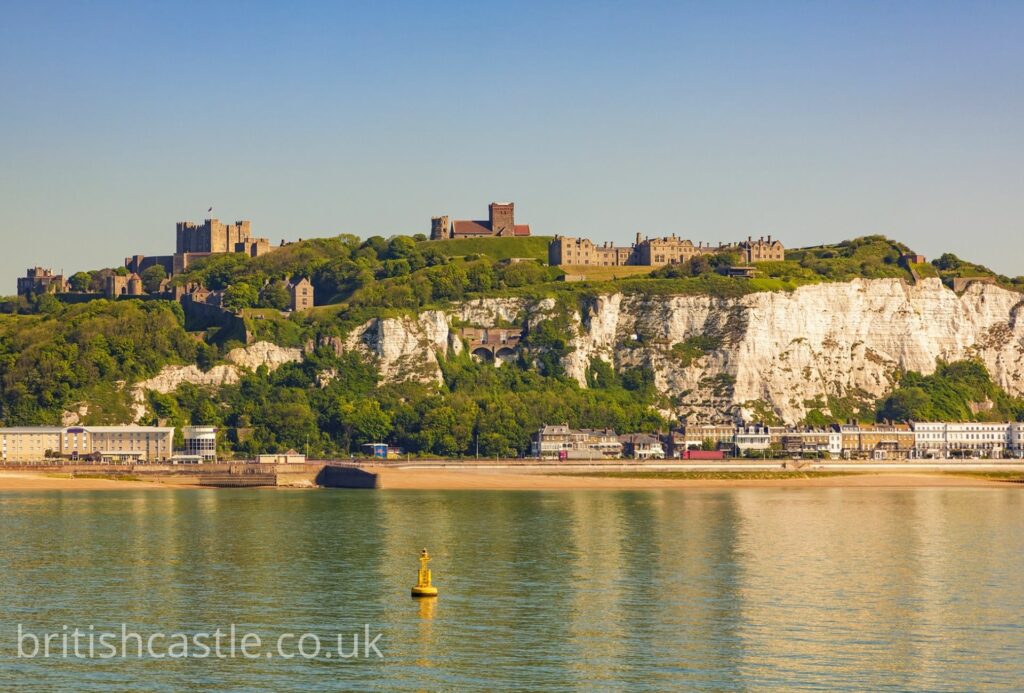
2. Warwick Castle: Warwick Castle was constructed in the 11th century by Henry de Beaumont under the orders of William the Conqueror. The castle was intended to be part of a defensive chain of castles to help William the Conqueror maintain control over his new territories. Warwick Castle was passed to William de Beauchamp around 1242 and would remain in possession of the Beauchamp family for nearly 200 years before eventually coming under the ownership of the crown in the 1500s. Today, Warwick Castle is owned by the Tussaud’s Group, an entertainment company that has opened the castle as a tourist attraction and completed extensive renovations.
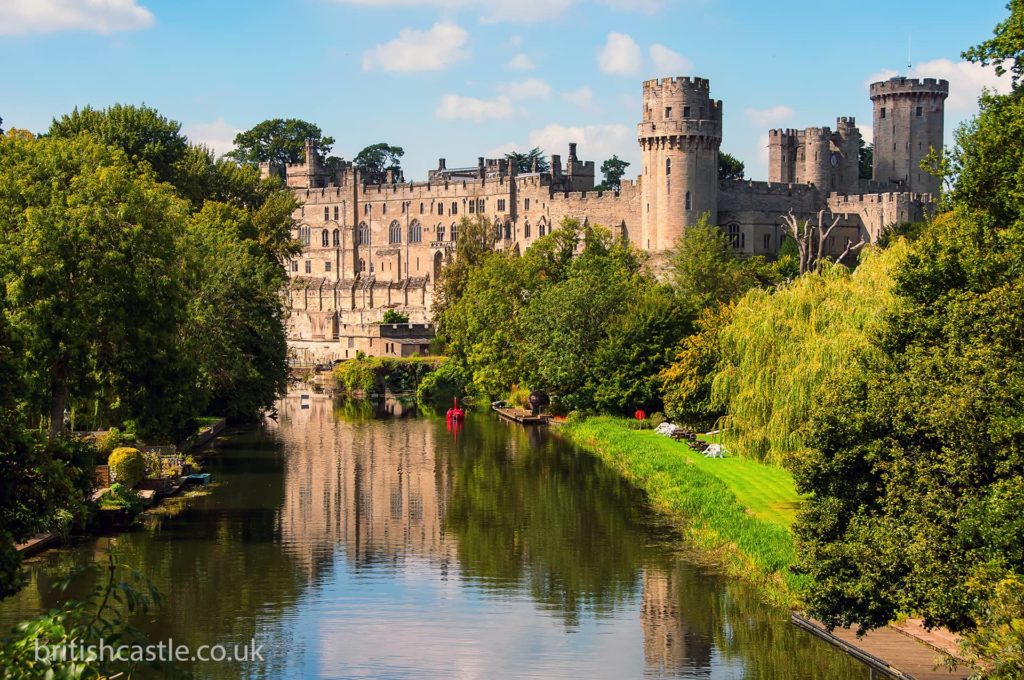
3. Leeds Castle: Leeds Castle is yet another castle site that originated in the 11th century as a Norman Stronghold. The castle came into the crown’s ownership sometime in the 13th century, serving as a residence for several royal family members — starting with Queen Eleanor of Castille in 1278. Most notably, Leeds Castle would come into the ownership of King Henry VIII, making it the Tudor palace that housed the king’s first wife, Katherine of Aragorn. In the present day, Leeds Castle is a top tourist attraction managed by the Leeds Castle Foundation, as well as serving as a vital conference venue that hosted Middle East peace talks in 1978.
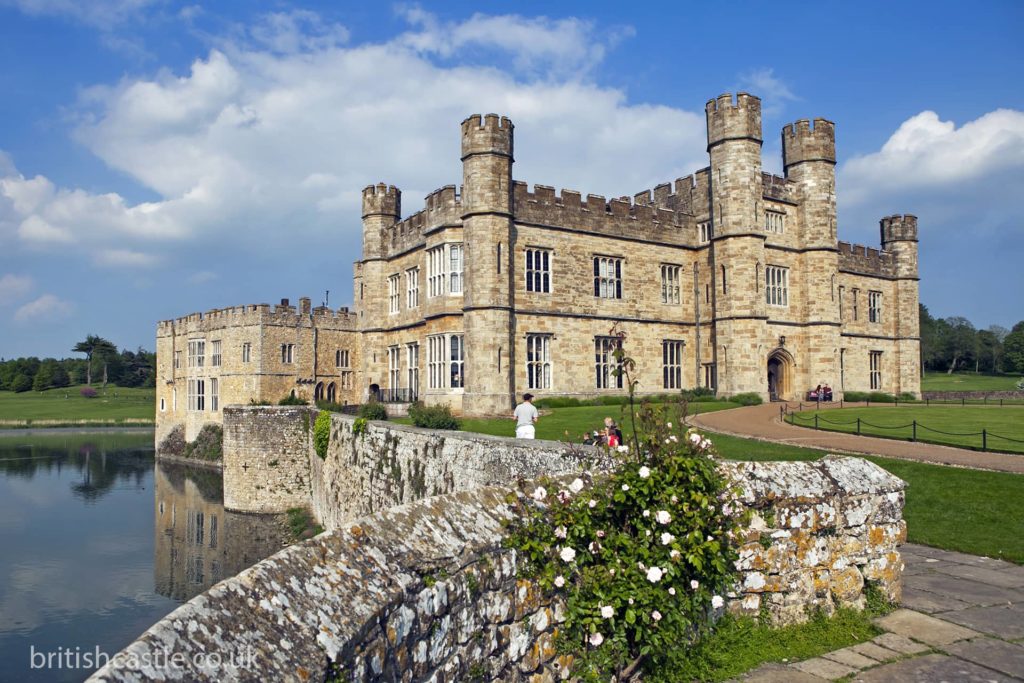
4. Bodiam Castle: Bodiam Castle is located in the Sussex region to the south of England. Built sometime around 1385 by Sir Edward Dallingridge, who was the Knight of the Shire of Sussex and became the Warden of London in 1392. Curiously, the castle was adorned with a series of ritual protective marks to help ward off evil — though these protective marks couldn’t stop the castle from falling into a state of ruin between the 15th to 17th centuries. Bodiam Castle was left in the care of the National Trust in 1925, though the castle was never restored.
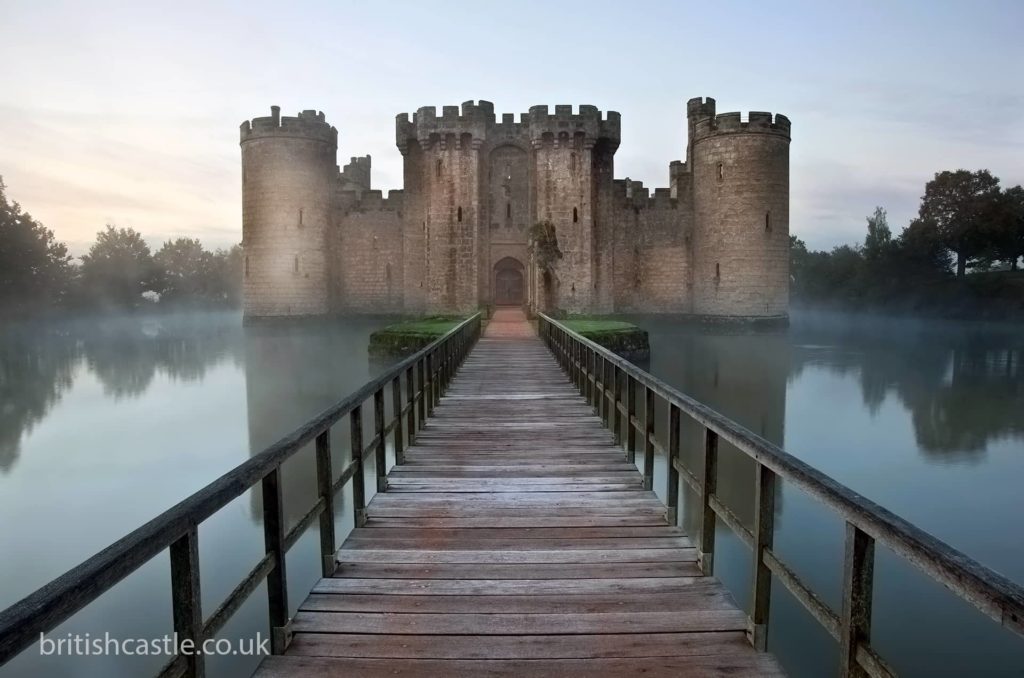
5. Arundel Castle: Arundel Castle overlooks the River Arun, built in West Sussex by the Earl of Arundel Roger de Montgomery in the late 11th century. Though the castle occasionally fell into the ownership of the crown, Arundel Castle was primarily passed down to the female heiresses of the d’Albini and later the Fitzalans family lines. Eventually landing into the ownership of the Howards in the 16th century, Arundel Castle became the seat of the Dukes of Norfolk. Today’s Arundel Castle is still in great condition, thanks largely to the restoration efforts of Henry the 15th Duke of Norfolk in 1900.
6. Dustanburgh Castle: Dustanburgh Castle was constructed in the early 14th century by Thomas the Earl of Lancaster — though Thomas would later be executed for his role in a rebellion against Edward II. Despite this event, the castle would later be returned to the ownership of Thomas’s younger brother, Henry. Most interestingly in Dustanburgh Castle’s history is the military role it would come to play in the Wars of the Roses of the 15th century. In today’s times, Dustanburgh Castle is a castle ruin site that offers dramatic views of the ruins against the coastline.
7. Corfe Castle: Corfe Castle was constructed in the early 12th century for William the Conqueror’s son, King Henry I. Later on, the castle would fall into the care of King John between 1199 to 1216. King John spent significant royal funds adding extra luxuries to the castle, including details from the trendiest architectural styles of the time. Corfe Castle continued to pass between various owners before becoming a centrepiece in the conflict between Parliament and King Charles I in the 1640s. Parliament ordered the destruction of Corfe Castle, reducing the once glorious castle to ruins. Today, the Corfe Castle ruins belong to the National Trust.
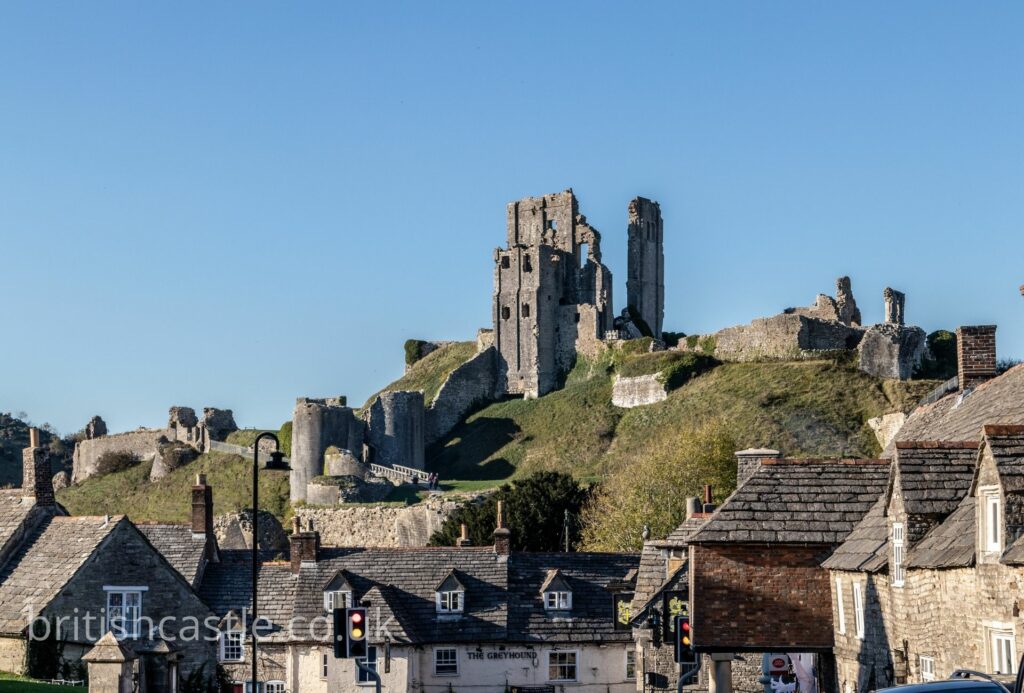
8. Kenilworth Castle: Kenilworth Castle was built in the 1120s by Geoffrey de Clinton, the royal chamberlain responsible for building the majority of the Norman keep. The castle was passed on to John of Gaunt — the son of King Edward III — in the 14th century. John of Gaunt put tremendous effort into developing the castle into a palace. These efforts were later expanded upon by Robert Dudley, Earl of Leicester, in the 1560s. In 1650, the English Civil War turned Kenilworth Castle into ruins, eventually falling into the hands of Sir John Siddeley in the 1930s, who is widely regarded as having saved the ruins and made them a public space. The castle site is now looked after by both the Armstrong Siddeley Heritage Trust and English Heritage.
9. Tintagel Castle: Tintagel Castle resides on a historical site that long pre-dates the construction of the actual castle. The castle site has been inhabited since the 5th century before the Tintagel Castle was built in the 1230s by Richard, Earl of Cornwall. Many suspect that the Earl chose the site for the castle construction due to the site’s association as the place of conception of King Arthur, a literary folk tale spread by Geoffrey of Monmouth. Though the castle site lies in ruins today, it still draws in many visitors thanks to its close ties to the legend of King Arthur.
10. Beeston Castle: Beeston Castle is widely regarded as one of the most dramatic castle ruin sites in all of England. The castle proved to be a pivotal location and territory to the two warring parties — Parliament and King Charles I — that started the English Civil War. Unfortunately, Beeston Castle was partially demolished following the events of the English Civil War and the surrender of the Royalists, supporters of King Charles I. In 1844, after falling under the ownership of John Tollemache (who later became the 1st Lord Tollemache of Helmingham), the Peckforton Castle was built on the southern hillside of the castle site, with the Beeston Castle ruins serving as an “integral part of Peckforton’s landscape,” according to English Heritage.
11. Peckforton Castle: Peckforton Castle is one of the youngest castles in this list, commissioned in 1844 by Sir John Tollemache and built by Anthony Salvin. The castle is designed in the style of a medieval castle, despite being constructed in the 1800s, and served a vital role as a refuge for disabled children fleeing from the events of World War II. Today, Peckforton Castle is used as an event venue for civil ceremonies, as well as a filming location for television and film. Notable TV series that have filmed at Peckforton Castle include BBC’s Doctor Who and Sherlock Holmes.
12. Bolsover Castle: Bolsover Castle was built sometime in the late 11th century by William Peveril, a knight of William the Conqueror. Despite its early founding, however, the castle would fall into a state of neglect and ruin by the time the 1600s rolled around. Yet, as the saying goes, one man’s trash is another man’s treasure — and in 1612, Sir Charles Cavendish decided the Bolsover Castle ruins provided the right setting for the construction of his Little Castle. The castle came into the care of English Heritage in 1984 and restoration efforts have been in progress ever since.
13. Bamburgh Castle: Bamburgh Castle is easily one of the most well-known historic royal fortresses in all of England. For more than 1,400 years, Bamburgh Castle stood as a key defensive structure above the coast of Northumberland, before turning into a castle ruins following neglect after the English Civil War. The castle would then come into the ownership of Lord Nathaniel Crewe, who set up a trust fund for the restoration of the castle following the death of his wife in the early 1700s. In the late 1800s, Bamburgh Castle was sold to the engineer and environmentalist William Armstrong, who spent more than one million pounds restoring the castle residence. Today, the castle remains a private residence of the Armstrong family, welcoming visitors to come and witness the historic building for themselves.
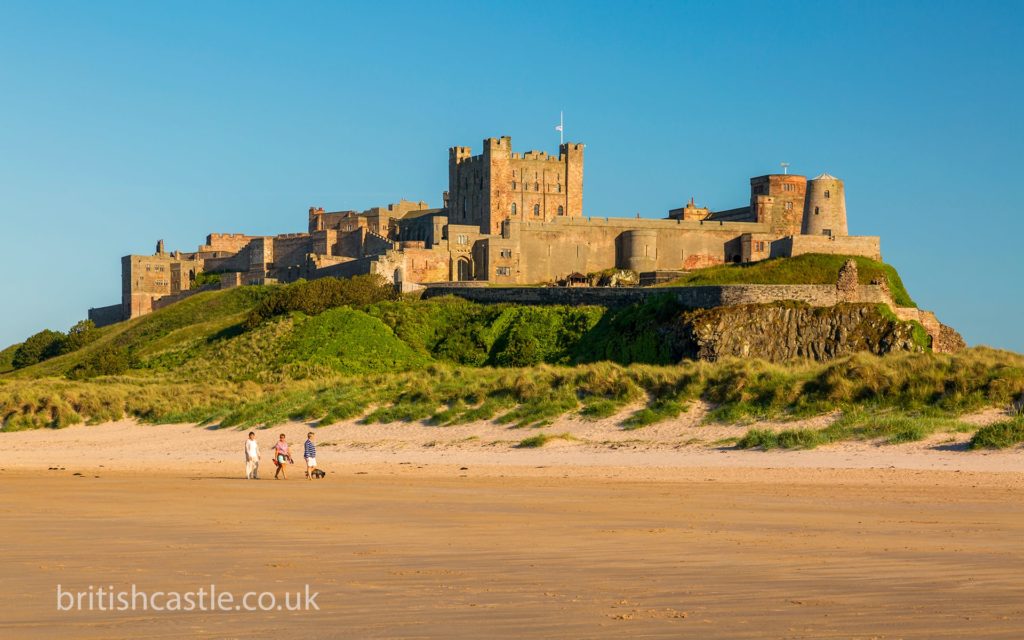
14. Alnwick Castle: Alnwick Castle is yet another of the remaining castle sites from the historic Norman Conquest of 1060. This castle is still in use and inhabited today, making it the second-largest inhabited castle in all of England — dwarfed only by Windsor Castle. The Percy family gained ownership of the castle in the early 1300s and the castle remains in their ownership today. Most notably, Alnwick Castle was used as a vital filming location for the Harry Potter movies, as well as other film and TV show settings. Alnwick Castle is now a popular tourist attraction located within Northumberland and is the current residence of the Duke of Northumberland.
15. Durham Castle: Durham Castle is another one of the Norman castles built in the early 11th century as part of the Norman Conquest. The castle came to hold an immensely important strategic position on the border of Scotland. As England moved in the medieval era, Durham Castle became an important setting for the Prince Bishops, who became powerful political players throughout the 13th and 14th centuries. Among these bishops was Cuthbert Tunstall, who would go on to inspire the philosopher Erasmus and expand Durham Castle to be a more grand and palace-like setting. The castle would eventually be donated to Durham University as both a historical site and a place for housing students, with the restored castle continuing to serve as a university dwelling for students to this day.
16. Hever Castle: Hever Castle was built in 1383, originally designed as a medieval defensive castle. However, after the famous Boleyn family gain possession of the castle in the 15th century, the Boleyns wasted no time transforming the castle into a more modernized aristocratic residence. Hever Castle was the childhood home of Anne Boleyn, who would later become the second wife of King Henry VII — and meet a terribly unfortunate demise shortly thereafter. The castle slowly fell into decline until it came into the ownership of William Waldorf Astor, who commissioned the Tudor Village and re-imagined Hever Castle as both his family home and a public attraction.
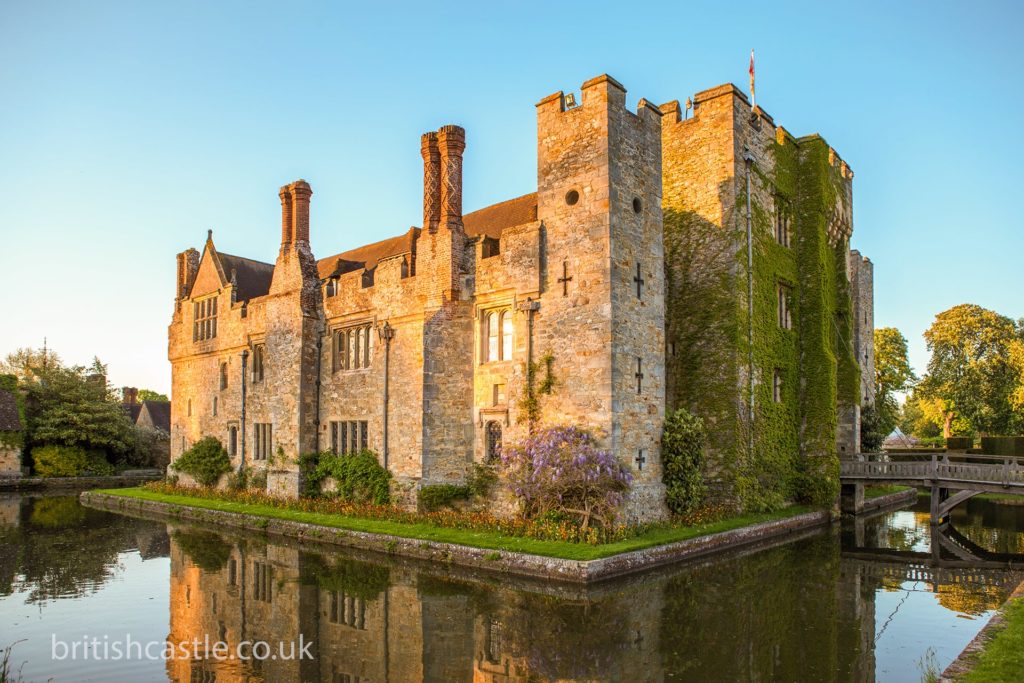
17. Goodrich Castle: The Goodrich Castle site was originally home to Godric’s Castle, built following the Norman Conquest sometime around 1101. That castle would quickly be reduced to ruins before Goodrich Castle was built in its place, pioneered by the nobleman Richard ‘Strongbow’ de Clare around 1148. However, the castle would once again be reduced to ruins during the English Civil War of the 1600s. The castle’s ruins still remain today as an ancient monument to England’s past, managed as a public tourist attraction by English Heritage.
18. Lindisfarne Castle: Lindisfarne Castle is located on the holy island of Lindisfarne, first founded sometime around 634 AD after Oswald, King of Northumbria gifted the island to the church. Lindisfarne Island proved to be an important military stronghold throughout several of England’s early conflicts before being brought into the ownership of King Henry VIII in 1534, when the Lindisfarne Castle was finally constructed and used as a base for the Tudor navy. The castle was later purchased by Edward Hudson and remodeled by Sir Edwin Lutyens. Today, Lindisfarne Castle is a public tourist attraction and event venue.
19. Rochester Castle: Rochester Castle is a stone castle that was built sometime in the 1080s by Gundulf, Bishop of Rochester. The castle became a symbol of medieval power, withstanding three separate sieges during the early 1200s. However, the castle fell into ruin in the 17th century before later being recognized as an ancient monument in the 1800s. Rochester Castle first passed into the ownership of the Ministry of Works in 1965 and then fell into the care of English Heritage in 1984. In 1995, Rochester Castle was placed under the management of the City of Rochester Medway Council, which continues to manage the keep and castle gardens today.
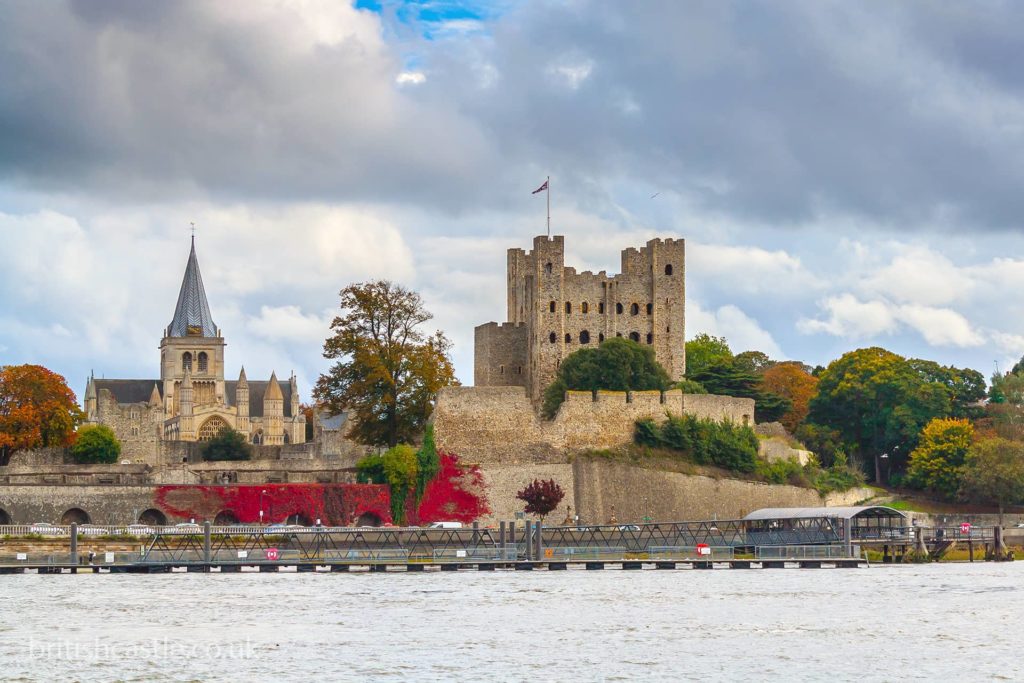
20. Berry Pomeroy Castle: Berry Pomeroy Castle has a bit more of a unique backstory than the other castles in this list, considering the castle was only constructed in the 15th century — despite many originally believing it was of Norman origins. The castle was commissioned by the Pomeroy family as a primarily defensive structure, though it did sadly fall into ruin in 1697. Today, the castle site is a picturesque ruin that has inspired artists and writers alike.
15 Famous Castles in Scotland, Wales, & Northern Ireland
There’s no denying that England is home to some of the most fascinating and historically rich castles and castle sites in all of the UK. However, we would be remiss to not also discuss several of the key castles within the histories of the other nations within the UK.
Here is a look into the history of 15 famous castles found in Scotland, Wales, and Northern Ireland:
Scotland
1. Edinburgh Castle: Edinburgh Castle is one of the oldest examples of a fortified palace in not just the UK but all of Europe. Before Scotland fell under the control of the Normans and later the British Kingdom, Edinburgh Castle served as a primary royal residence for the Scottish monarchs. From the late 1200s onward, Edinburgh Castle was subjected to many different battles, invasions, and attempted sieges — even going on to be a holding area for prisoners of war between 1757 to 1814. Parts of the castle are still used for military purposes today, and the castle was named a UNESCO World Heritage site in 1995. The castle also serves as the repository of the Honours of Scotland — the Scottish crown jewels.
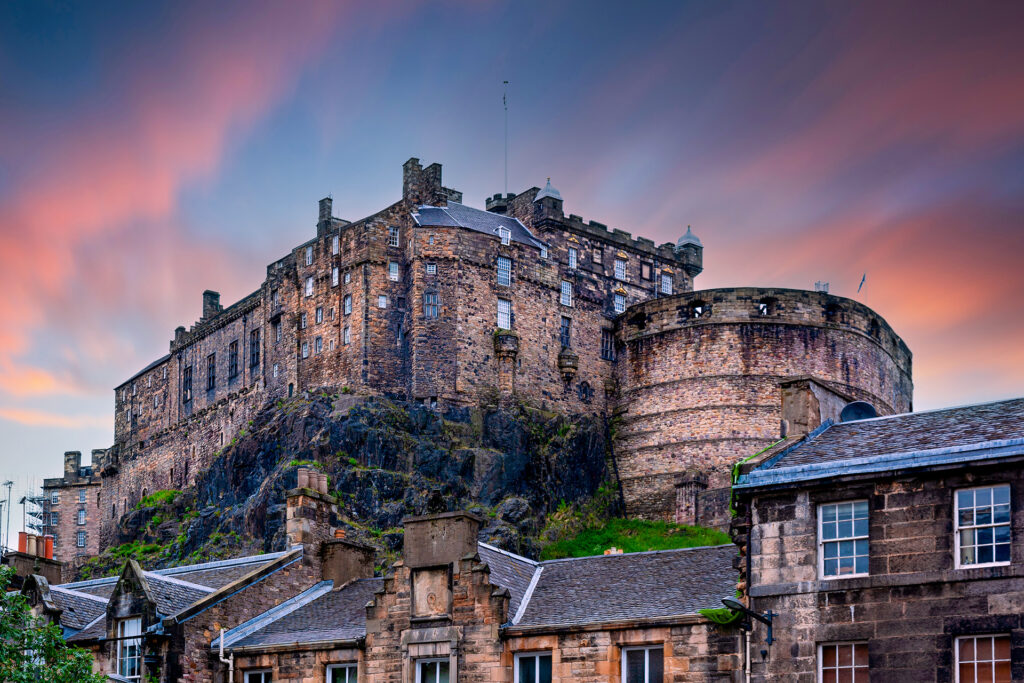
2. Glamis Castle: Glamis Castle holds more than 1,000 years of Scottish history and is the ancestral seat to the Earl of Strathmore and Kinghorne. In 1034, Malcolm II was murdered on the Glamis site, which later inspired William Shakespeare’s Macbeth tragedy. The Glamis Castle was not constructed until around 1372 but still required restoration in the late 1600s due to the castle’s uninhabitable conditions following the Commonwealth of England, Scotland, and Ireland. During restoration efforts, a major Baroque garden was added to the site. The castle went on to be the birthplace of Princes Margaret in 1930 and was later opened to the public in 1950.
3. Tantallon Castle: Tantallon Castle was built as a fortress in the mid-1300s by the Scottish nobleman William Douglas, the Earl of Douglas. The castle was passed down through the branches of the Douglas family for 300 years before receiving a devastating blow from Oliver Cromwell in 1651 that caused the castle to be abandoned. Today, the Tantallon Castle ruins stand as a testament to the medieval and middle-age strength of the Scots, as well as offering key insights into the style and techniques of Scottish architecture.
4. Stirling Castle: Stirling Castle was constructed sometime around 1110, built high on a volcanic outcrop that allowed the castle to guard a key crossing point in the River Forth. The castle’s design was incredibly complex, featuring three main enclosures that made the castle similar to a concentric-style castle. Many of the castle’s inner buildings are principal occupations for royalty, most of which were commissioned by James IV, James V, and James VI between 1496 to 1594. Stirling Castle was a major stronghold in the Wars of Independence with England and remains a still-standing castle to this day.
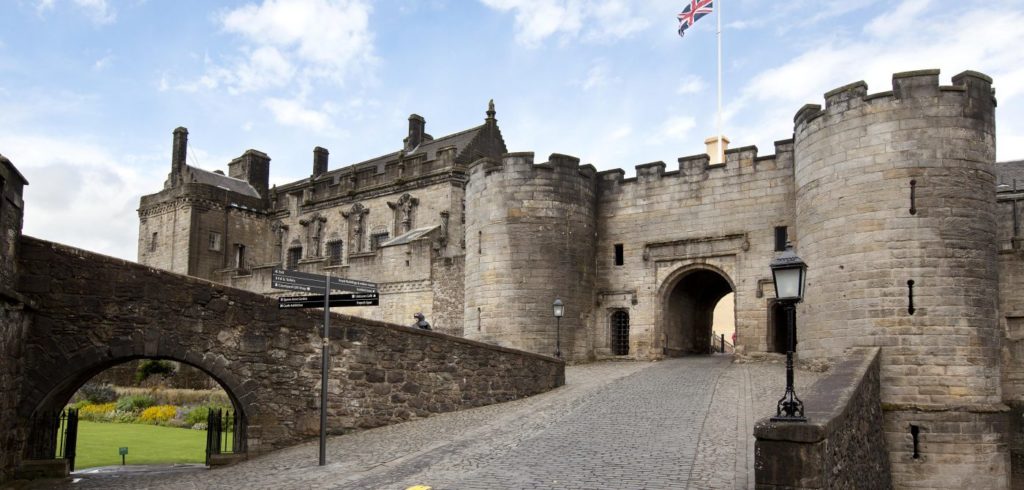
5. Balmoral Castle: Balmoral Castle is an estate house that serves as a royal residence for the British monarch and royal family. The estate was purchased from the Farquharson family in 1852 by Prince Albert and Queen Victoria, wherein Scottish architects John and William Smith fashioned the estate after the Scottish baronial and Gothic revival architectural styles. Balmoral Castle has been undergoing new renovations and is expected to reopen to the public sometime in April of 2023.
Wales
1. Conwy Castle: Conwy Castle was built by Edward I of England in 1283, with construction being completed in 1292. The castle was designed to incorporate all of the latest defensive features of the time period, such as a double courtyard bailey and outer defensive walls. Conwy Castle would go on to be famously used as a place of refuge by King Richard II of England after having to fight for the crown and throne with his cousin, Henry Bolingbroke. Richard II would fall victim to a traitorous advisor who tricked him into being imprisoned. Conwy Castle is now a UNESCO World Heritage site and is regarded as one of the best examples of 13th to 14th century military architecture in all of Europe.
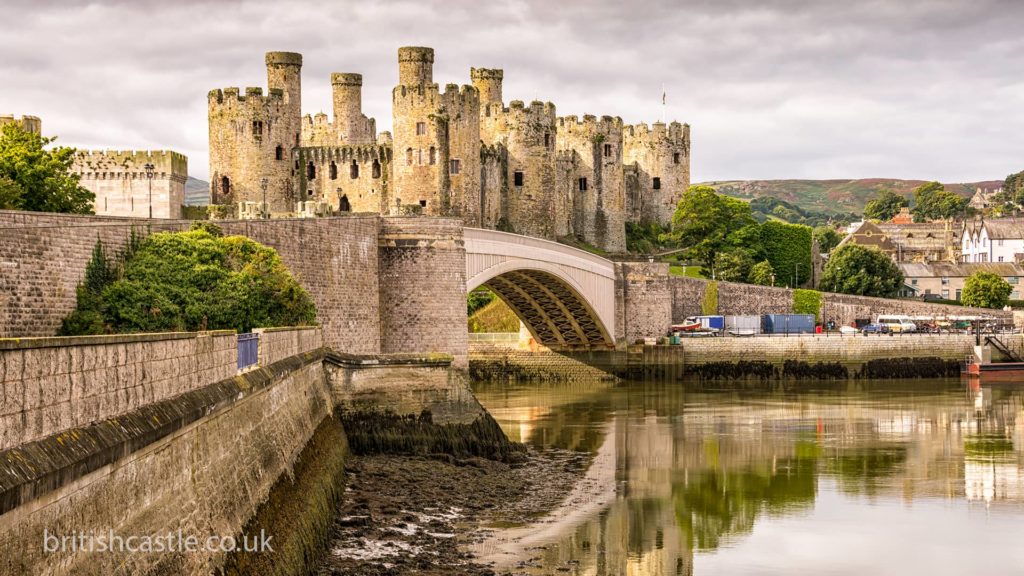
2. Cardiff Castle: Cardiff Castle has more than 2,000 years of history in Wales, with humble beginnings as a Roman fort as early as the 50s AD. During the Norman Conquest, Cardiff Castle became an important stronghold and the castle’s keep was formed from the site of the original Roman fort. The castle went on to pass through many noble families until ending up in the care of the Bute family, who commissioned architect William Burges to transform the castle into a lavish palace. Since 1974, the castle has been a popular tourist attraction in Wales.
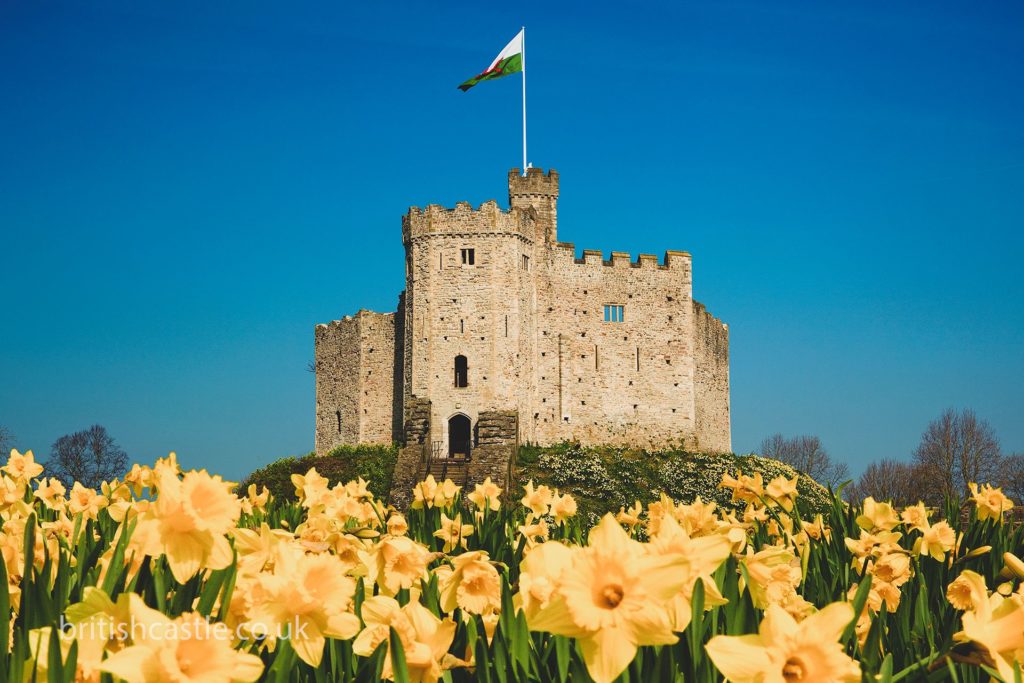
3. Pembroke Castle: Pembroke Castle started as merely a small inner bailey created in 1093 by Arnulf de Montgomery. The castle’s keep would later be constructed in the 12th century, featuring several architectural anomalies for the time, such as a cylindrical tower with a stone dome sitting atop it. Despite falling into ruin and decay after the Second Civil War between England and Wales, the castle would undergo extensive restoration efforts throughout the 1900s commissioned by Major-General Sir Ivor Philipps. Following Sir Ivor’s death, a trust was created for the castle that is now managed by the Philipps family and the Pembroke town council.
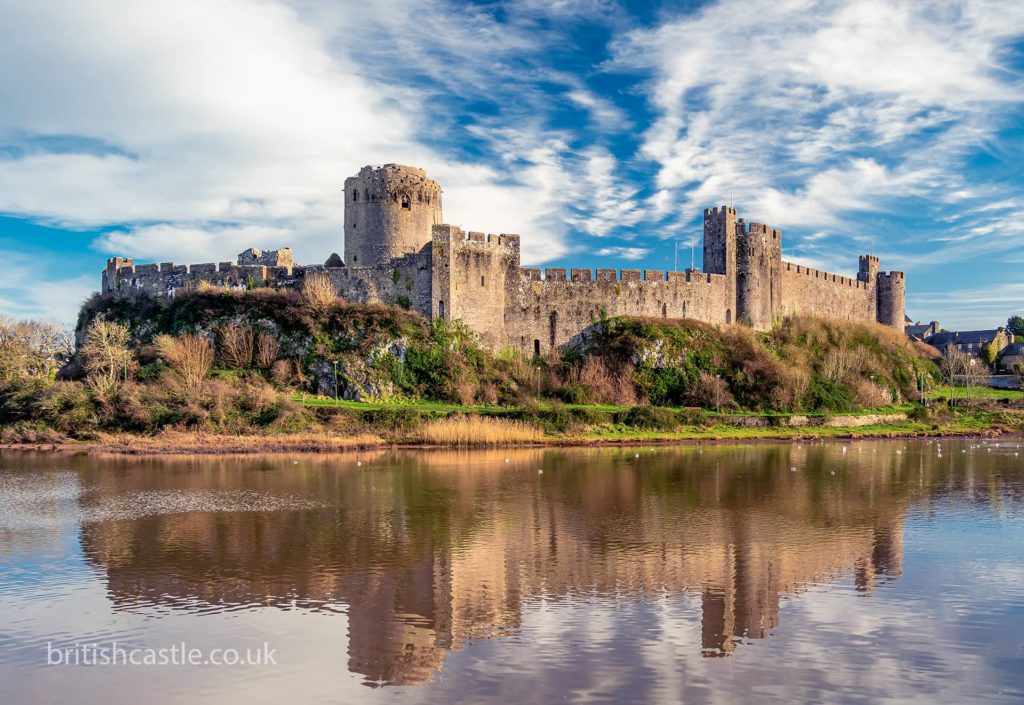
4. White Castle: White Castle — also known as Llantilio Castle — is a present-day castle ruin site that was first established as part of a trio of castles known as the Three Castles. Today, White Castle is the best preserved of the Three Castles, which were originally designed with the purpose to protect the Welsh border. In 1909, after several changes in ownership, the castle was deemed an ancient monument and placed under the care of the state in 1922. White Castle is now a thriving tourist attraction and castle ruin site that is open to the public.
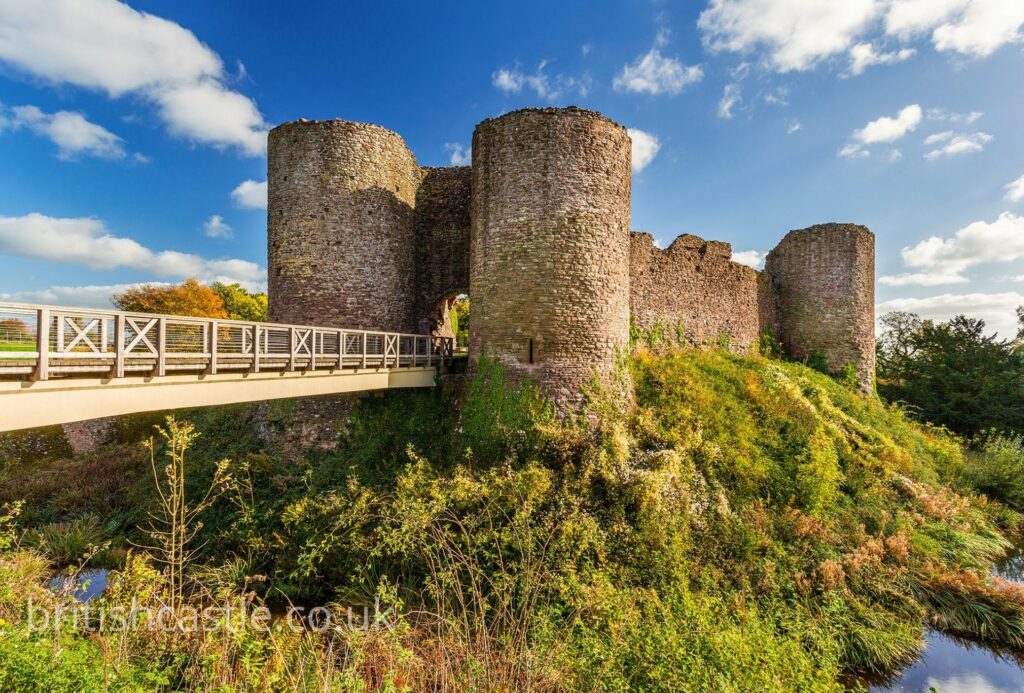
5. Powis Castle: Powis Castle was built in the mid-13th century by Gruffudd ap Gwenwynwyn, a Welsh prince trying to establish his independence. Meanwhile, Llywelyn ap Gruffudd of Gwynedd was also trying to establish himself as a Prince of Wales, succeeding in his efforts by the late 13th century and laying waste to Powis Castle. In 1952, Powis Castle was handed over to the National Trust, which has implemented extensive restoration efforts ever since.
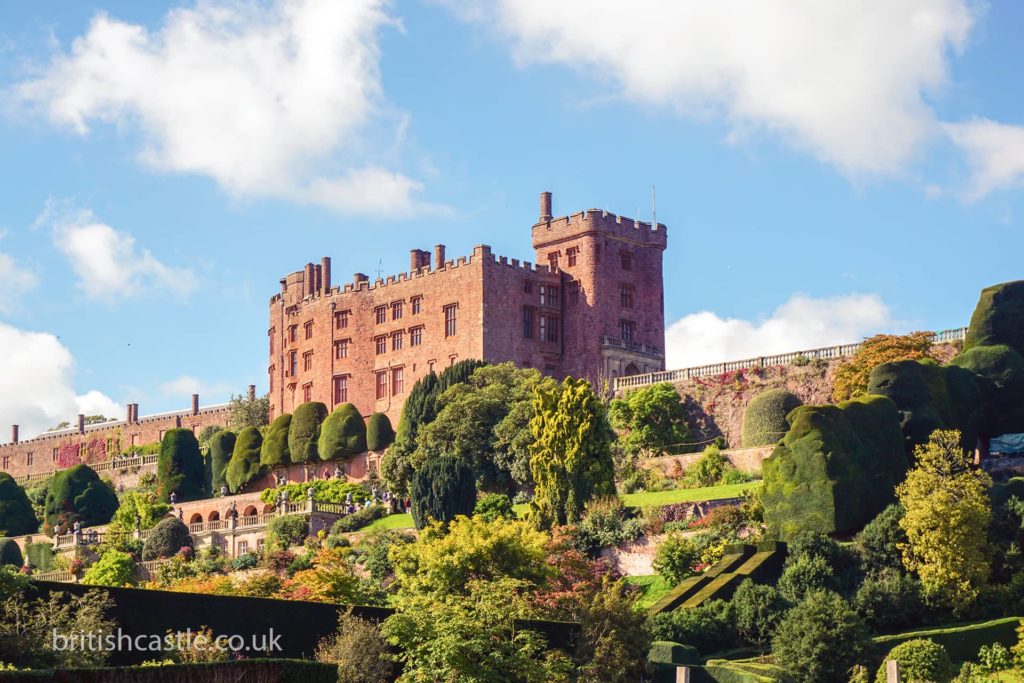
Northern Ireland
1. Dunluce Castle: Dunluce Castle was built by Richard Óg de Burgh, the 2nd Earl of Ulster, in the 13th century. Though reduced to ruins today, this medieval castle site was once the home of the chief of the Clan MacDonnell of Antrim. The castle served as the seat of the Earl of Antrim until the MacDonnells fell into poverty in the 1690s. Dunluce Castle has gone on to serve as a filming location for Game Thrones, used as the castle set for the House Greyjoy’s castle of Pyke.
2. Belfast Castle: Belfast Castle is one of the most famous landmarks in all of Northern Ireland, known for its iconic position in Cave Hill Country Park. The castle’s original form is estimated to have been built around the late 12th century by the Normans. Though a second castle was built in 1611, it burned down nearly 100 years later. In 1862, a new Belfast Castle was constructed on the site, with the estate passing down family lines until eventually being presented as a gift to the city of Belfast in 1934. Today, Belfast Castle is a tourist attraction and event venue.
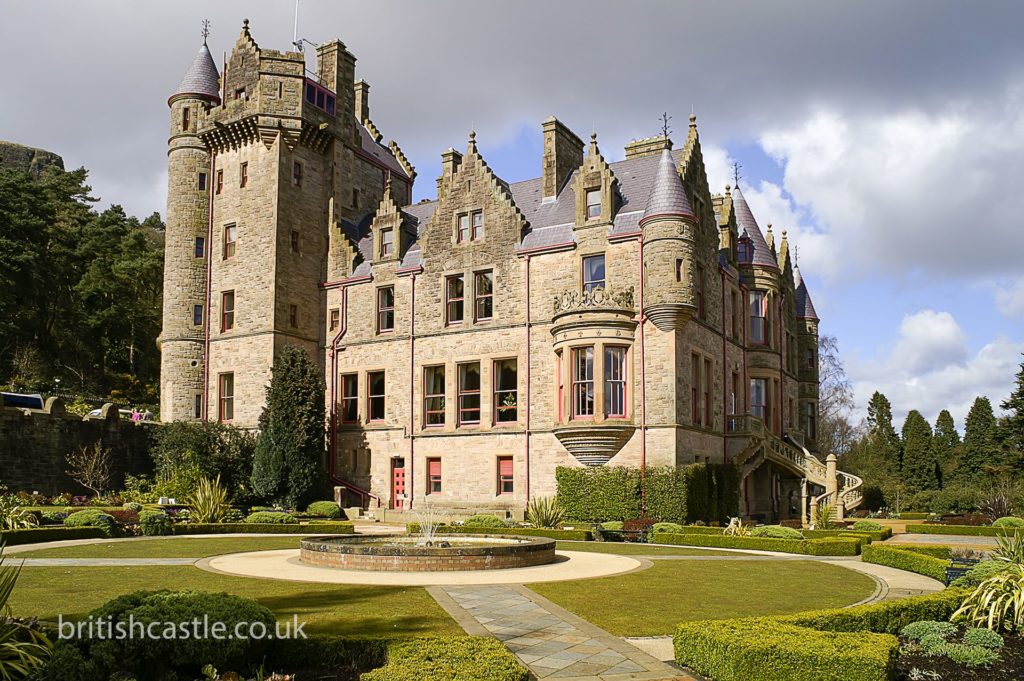
3. Monea Castle: Monea Castle was built around 1618 by the Reverend Malcolm Hamilton in a tower house architectural style. The castle was built during the Plantation and was often used as a storehouse and place of residence by the Planters. During the Irish Rebellion of 1641, Monea Castle was attacked by Rory Maguire due to the castle offering refuge to Protestants. In 1705, the Monea Castle was destroyed by a fire and abandoned. The Monea Castle ruins today are freely accessible to the public.
4. Carrickfergus Castle: Carrickfergus Castle was created during the Norman Conquest, built by John de Courcy in 1177 as a Norman headquarters. The castle played a key military role in conflicts with the Scottish, Irish, English, and French up until 1928. Carrickfergus Castle is considered to be one of the best-preserved medieval structures in Northern Ireland. Though no longer functional, the castle ruins are well-kept and open to visitors.
5. Gosford Castle: Gosford Castle was constructed in 1819, though the castle would not be completed until the 1850s. The castle was commissioned by Archibald Acheson, the 2nd Earl of Gosford, who assigned Thomas Hooper as the lead architect for the project. Gosford Castle is designed with a Norman-revival style. This castle has undergone a variety of random restoration efforts and even served as a filming location for Game of Thrones,
Final Thoughts
The history of castles in Great Britain and the greater UK region is ripe with historical drama, royal lineage, and architectural ingenuity. As one of the longest-standing world powers, the UK has a lot of history to share with the world — and its castles offer unique windows into the ancient and medieval worlds that helped form the UK as it is today.
Leave a Reply